- Inicio
- Acerca de nosotros
- Industria
- Servicios
- Leyendo
- Contáctenos
Mercado de malformaciones linfáticas: análisis actual y pronóstico (2023-2030)
Énfasis en la aplicación (diagnóstico y tratamiento); Usuario final (hospitales, clínicas y otros); y Región/País
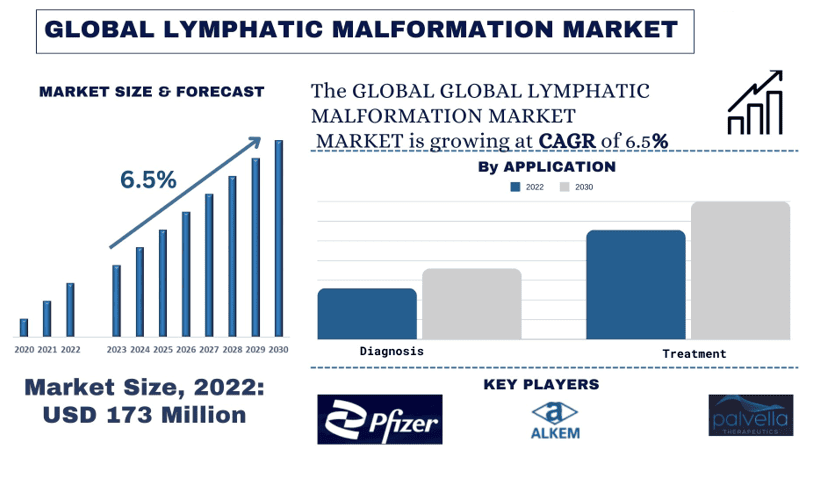
Tamaño y previsión del mercado de malformaciones linfáticas
El mercado de malformaciones linfáticas se valoró en 173,24 millones de dólares en 2022 y se espera que crezca a una CAGR del 6,54% durante el período de previsión (2023-2030).
Análisis del mercado de malformaciones linfáticas
Las malformaciones linfáticas (ML) son anomalías congénitas del sistema linfático, caracterizadas por un crecimiento y desarrollo anormales de los vasos linfáticos. Estas malformaciones pueden ocurrir en cualquier parte del cuerpo, pero se encuentran principalmente en la región de la cabeza y el cuello, incluyendo la cara, el cuello y la cavidad oral. La malformación linfática ganó prominencia principalmente en el mercado debido a las crecientes iniciativas gubernamentales para desarrollar tratamientos para la dolencia. Por ejemplo, en marzo de 2024, el Instituto Nacional del Corazón, los Pulmones y la Sangre ayudó a lanzar los primeros Institutos Nacionales de la Salud-Comisión Nacional de Enfermedades Linfáticas para establecer un organismo nacional para avanzar en la investigación linfática. Además de esto, las inversiones en los departamentos de salud, así como los programas de sensibilización del gobierno con respecto a la malformación linfática han aumentado significativamente en los últimos años, que son los factores clave que están creando oportunidades para el mercado.
Pfizer Inc.; Protara Therapeutics; Zydus Pharmaceuticals, Inc.; Palvella Therapeutics; Avalo Therapeutics, Inc.; Alkem Laboratories Ltd.; GLENMARK PHARMACEUTICALS LTD. son algunos de los actores clave en el mercado. Varias fusiones y adquisiciones junto con asociaciones han sido emprendidas por estos jugadores para facilitar a los clientes productos/tecnologías de alta tecnología e innovadores.
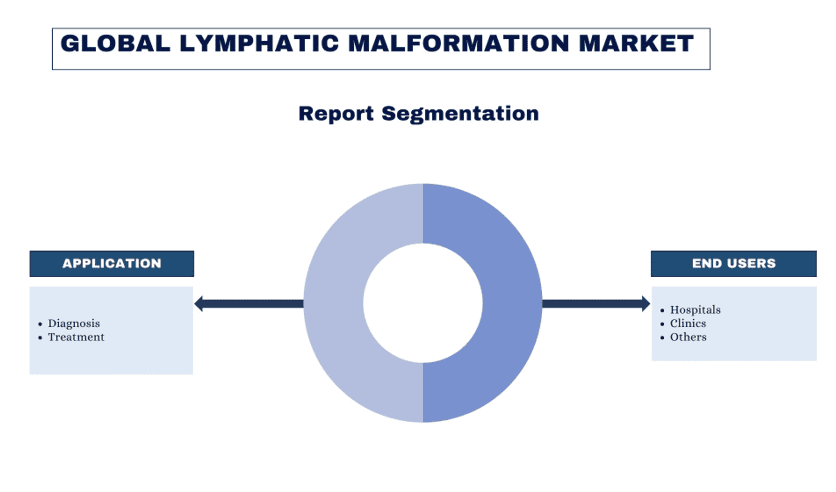
Tendencias del mercado de malformaciones linfáticas
"Entre las aplicaciones, la categoría de tratamiento será testigo de una mayor CAGR durante el período de previsión"
Basado en la aplicación, el mercado se bifurca en diagnóstico y tratamiento. Se espera que el segmento de tratamiento crezca con una alta CAGR durante el período de pronóstico debido al creciente número de ensayos clínicos. Por ejemplo, en febrero de 2023, Novartis Pharmaceuticals inició un estudio en participantes con malformaciones linfáticas mutadas por PIK3CA (LyM) para evaluar el cambio en la respuesta radiológica y la gravedad de los síntomas tras el tratamiento con alpelisib en comparación con el placebo. Las compañías farmacéuticas y las instituciones académicas están invirtiendo en investigación y desarrollo para desarrollar nuevas estrategias de tratamiento para la retinopatía linfática. El crecimiento del segmento de tratamiento está impulsado por la innovación tecnológica, el aumento de la prevalencia de la enfermedad, la mejora del acceso a los servicios de salud y un creciente énfasis en la intervención temprana y los enfoques de terapia combinada. Por lo tanto, se espera que el segmento de tratamiento entre las aplicaciones sea testigo de una mayor CAGR durante el período de pronóstico.
"Entre los usuarios finales, los hospitales tuvieron una participación significativa en el mercado en 2022"
Basado en el usuario final, el mercado se clasifica en hospitales, clínicas y otros. El segmento de hospitales está dominando el mercado debido al aumento de los ingresos hospitalarios por malformaciones linfáticas a nivel mundial. Esto se debe a las pruebas de diagnóstico más altas de malformaciones linfáticas en los hospitales, ya que la mayoría de los equipos de diagnóstico están disponibles en entornos hospitalarios. Aparte de esto, el creciente número de hospitales también está impulsando el crecimiento segmentario. Por ejemplo, según la American Hospital Association, había alrededor de 6.093 hospitales en los EE. UU. en octubre de 2022, que comprende hospitales comunitarios administrados por organizaciones sin fines de lucro, así como por gobiernos estatales y locales. Por lo tanto, los hospitales tenían una participación significativa en el mercado de malformaciones linfáticas en 2022.
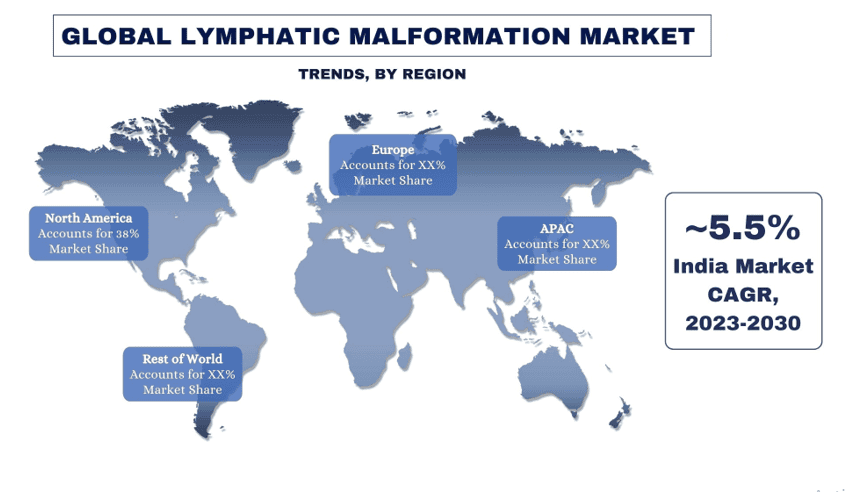
"Entre las regiones, se espera que APAC sea testigo de una mayor CAGR durante el período de pronóstico"
Se espera que APAC crezca con una alta CAGR en el mercado global de malformaciones linfáticas en el período de pronóstico. Varios factores, como el aumento en el número de ensayos clínicos que se están realizando, la accesibilidad mejorada y los costos de atención médica diversificados están impulsando el crecimiento del mercado durante el período de pronóstico. Además, el aumento de la incidencia de malformación linfática también está teniendo un impacto positivo en el crecimiento del mercado. Ha habido importantes programas de sensibilización sobre la malformación linfática y el lanzamiento de productos en la región. Por ejemplo, en marzo de 2021, ARTham Therapeutics, con sede en Japón, recibió una subvención para el desarrollo de medicamentos para enfermedades raras de la Agencia para la Investigación y el Desarrollo Médico para su programa ART-001 para el desarrollo del tratamiento de malformaciones vasculares de flujo lento. Por lo tanto, se espera que APAC sea testigo de una mayor CAGR durante el período de pronóstico.
Cobertura del informe del mercado de malformaciones linfáticas
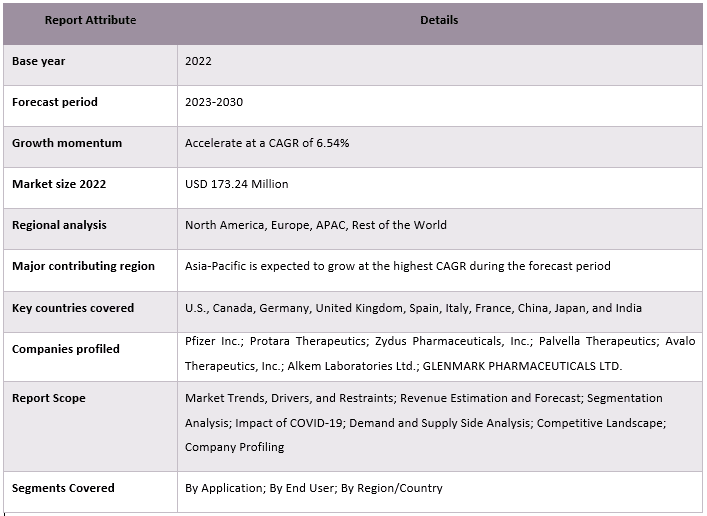
Razones para comprar este informe:
- El estudio incluye análisis de tamaño y previsión del mercado validados por expertos clave autenticados de la industria.
- El informe presenta una revisión rápida del desempeño general de la industria de un vistazo.
- El informe cubre un análisis en profundidad de los pares prominentes de la industria con un enfoque principal en las finanzas clave del negocio, la cartera de productos, las estrategias de expansión y los desarrollos recientes.
- Examen detallado de los impulsores, las restricciones, las tendencias clave y las oportunidades que prevalecen en la industria.
- El estudio cubre de manera integral el mercado en diferentes segmentos.
- Análisis profundo a nivel regional de la industria.
Opciones de personalización:
El mercado global de malformaciones linfáticas puede personalizarse aún más según el requisito o cualquier otro segmento de mercado. Además de esto, UMI entiende que puede tener sus propias necesidades comerciales, por lo tanto, no dude en conectarse con nosotros para obtener un informe que se adapte completamente a sus requisitos.
Tabla de contenido
Metodología de investigación para el análisis del mercado de malformaciones linfáticas (2023-2030)
El análisis del mercado histórico, la estimación del mercado actual y la previsión del mercado futuro del mercado mundial de malformaciones linfáticas fueron los tres pasos principales que se llevaron a cabo para crear y analizar la adopción de malformaciones linfáticas en las principales regiones del mundo. Se llevó a cabo una exhaustiva investigación secundaria para recopilar las cifras históricas del mercado y estimar el tamaño actual del mercado. En segundo lugar, para validar estas ideas, se consideraron numerosos hallazgos y supuestos. Además, también se realizaron exhaustivas entrevistas primarias con expertos de la industria en toda la cadena de valor del mercado mundial de malformaciones linfáticas. Tras la suposición y la validación de las cifras del mercado a través de entrevistas primarias, empleamos un enfoque de arriba hacia abajo/de abajo hacia arriba para pronosticar el tamaño completo del mercado. Posteriormente, se adoptaron métodos de desglose del mercado y de triangulación de datos para estimar y analizar el tamaño del mercado de los segmentos y subsegmentos de la industria a la que pertenece. A continuación, se explica la metodología detallada:
Análisis del tamaño histórico del mercado
Paso 1: Estudio en profundidad de fuentes secundarias:
Se llevó a cabo un estudio secundario detallado para obtener el tamaño histórico del mercado de malformaciones linfáticas a través de fuentes internas de la empresa, como informes anuales y estados financieros, presentaciones de resultados, comunicados de prensa, etc., y fuentes externas, como revistas, noticias y artículos, publicaciones gubernamentales, publicaciones de la competencia, informes sectoriales, bases de datos de terceros y otras publicaciones creíbles.
Paso 2: Segmentación del mercado:
Después de obtener el tamaño histórico del mercado de malformaciones linfáticas, llevamos a cabo un análisis secundario detallado para recopilar información histórica del mercado y compartirla para diferentes segmentos y subsegmentos para las principales regiones. Los principales segmentos incluidos en el informe son la aplicación, el usuario final y las regiones. Además, se llevaron a cabo análisis a nivel de país para evaluar la adopción general de los modelos de prueba en esa región.
Paso 3: Análisis de factores:
Después de adquirir el tamaño histórico del mercado de diferentes segmentos y subsegmentos, llevamos a cabo un análisis de factores detallado para estimar el tamaño actual del mercado de malformaciones linfáticas. Además, llevamos a cabo un análisis de factores utilizando variables dependientes e independientes, como la aplicación, el usuario final y las regiones de la malformación linfática. Se llevó a cabo un análisis exhaustivo de los escenarios de demanda y oferta teniendo en cuenta las principales asociaciones, fusiones y adquisiciones, la expansión empresarial y los lanzamientos de productos en el sector del mercado de malformaciones linfáticas en todo el mundo.
Estimación y previsión del tamaño actual del mercado
Tamaño actual del mercado: Basándonos en la información práctica de los 3 pasos anteriores, llegamos al tamaño actual del mercado, los actores clave en el mercado mundial de malformaciones linfáticas y las cuotas de mercado de los segmentos. Todos los porcentajes de participación requeridos y los desgloses del mercado se determinaron utilizando el enfoque secundario mencionado anteriormente y se verificaron a través de entrevistas primarias.
Estimación y previsión: Para la estimación y la previsión del mercado, se asignaron ponderaciones a diferentes factores, incluidos los impulsores y las tendencias, las restricciones y las oportunidades disponibles para las partes interesadas. Después de analizar estos factores, se aplicaron técnicas de previsión relevantes, es decir, el enfoque de arriba hacia abajo/de abajo hacia arriba, para llegar a la previsión del mercado para 2030 para diferentes segmentos y subsegmentos en los principales mercados a nivel mundial. La metodología de investigación adoptada para estimar el tamaño del mercado abarca:
- El tamaño del mercado de la industria, en términos de ingresos (USD) y la tasa de adopción del mercado de malformaciones linfáticas en los principales mercados nacionales
- Todos los porcentajes de participación, divisiones y desgloses de los segmentos y subsegmentos del mercado
- Actores clave en el mercado mundial de malformaciones linfáticas en términos de productos ofrecidos. Además, las estrategias de crecimiento adoptadas por estos actores para competir en el mercado de rápido crecimiento
Validación del tamaño y la cuota de mercado
Investigación primaria: Se realizaron entrevistas en profundidad con los Key Opinion Leaders (KOLs), incluidos los ejecutivos de alto nivel (CXO/VP, jefe de ventas, jefe de marketing, jefe de operaciones, jefe regional, jefe de país, etc.) en las principales regiones. A continuación, se resumieron los resultados de la investigación primaria y se realizó un análisis estadístico para demostrar la hipótesis establecida. Las aportaciones de la investigación primaria se consolidaron con los resultados secundarios, convirtiendo así la información en conocimientos prácticos.
División de los participantes primarios en diferentes regiones
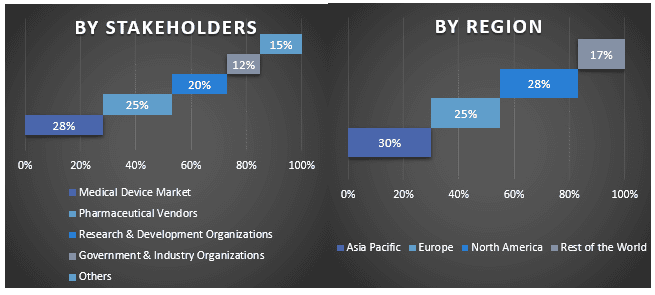
Ingeniería de mercado
Se empleó la técnica de triangulación de datos para completar la estimación general del mercado y llegar a cifras estadísticas precisas para cada segmento y subsegmento del mercado mundial de malformaciones linfáticas. Los datos se dividieron en varios segmentos y subsegmentos después de estudiar varios parámetros y tendencias en las áreas de aplicación, usuario final y regiones en el mercado mundial de malformaciones linfáticas.
El objetivo principal del estudio del mercado mundial de inhibidores del proteasoma
Las tendencias actuales y futuras del mercado mundial de malformaciones linfáticas se señalaron en el estudio. Los inversores pueden obtener información estratégica para basar su criterio para las inversiones en el análisis cualitativo y cuantitativo realizado en el estudio. Las tendencias actuales y futuras del mercado determinaron el atractivo general del mercado a nivel regional, proporcionando una plataforma para que el participante industrial explote el mercado sin explotar para beneficiarse de una ventaja de ser el primero en actuar. Otros objetivos cuantitativos de los estudios incluyen:
- Analizar el tamaño actual y previsto del mercado de malformaciones linfáticas en términos de valor (USD). Además, analizar el tamaño actual y previsto del mercado de diferentes segmentos y subsegmentos.
- Los segmentos del estudio incluyen áreas de aplicación, usuario final y regiones.
- Definir y analizar el marco regulatorio para la industria de las malformaciones linfáticas.
- Analizar la cadena de valor involucrada con la presencia de varios intermediarios, junto con el análisis de los comportamientos de los clientes y competidores de la industria.
- Analizar el tamaño actual y previsto del mercado de malformaciones linfáticas para la región principal.
- Los principales países de las regiones estudiadas en el informe incluyen Asia Pacífico, Europa, América del Norte y el resto del mundo.
- Perfiles de empresas del mercado de malformaciones linfáticas y las estrategias de crecimiento adoptadas por los participantes del mercado para mantenerse en el mercado de rápido crecimiento.
- Análisis regional profundo de la industria.
Preguntas frecuentes Preguntas frecuentes
P1: ¿Cuál es el tamaño actual del mercado y el potencial de crecimiento del mercado de malformaciones linfáticas?
P2: ¿Cuáles son los factores impulsores del crecimiento del mercado de malformaciones linfáticas?
P3: ¿Qué segmento tiene la mayor cuota del mercado de malformaciones linfáticas por aplicación?
P4: ¿Cuáles son las tecnologías emergentes y las tendencias en el mercado de malformaciones linfáticas?
P5: ¿Qué región dominará el mercado de malformaciones linfáticas?
P6: ¿Quiénes son los actores clave que operan en el mercado de malformaciones linfáticas?
Relacionados Informes
Los clientes que compraron este artículo también compraron










